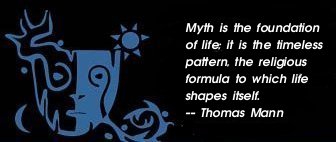|

Sainte-Baume Grotto: Mary Magdalene & The Zero Point
Part II
Photo-essay © 2007 Dahna Barnett
A portion of the grotto's floor is inlaid in red, white and black tiles. The cave's walls are these colors and they have been used in cave art since prehistoric times. These pigments tend to connote birth, life and death. Red, white and black are also colors connected with the Knights Templar. This organization was formerly active and continues to exist in Provence.
One of the black tiles near the bottom right is engraved with a geometric symbol that resembles our modern symbol for the atom.
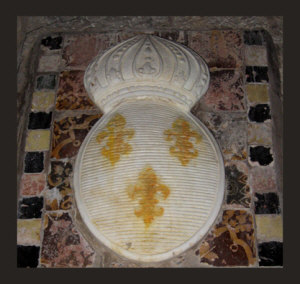
A carving, topped by a crown and encrusted with gold fleur-de-lys, rises from the tiles. The object could symbolize a hive, a bee, or a pupa. The French Merovingian kings used bees as one of their sacred devices.
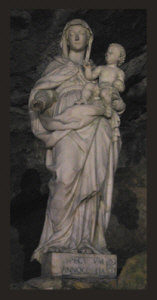
Notre Dame de Consolation sits on a rock outcrop
to the left of the chapel.
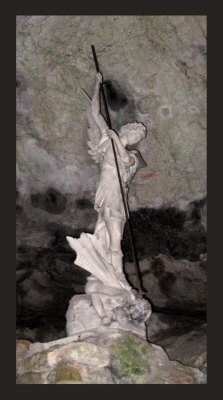
St George stands on a rock ledge above her.
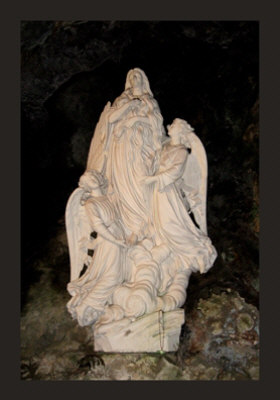
An estimated twelve-foot-tall statue of Mary Magdalene depicts her ascension.
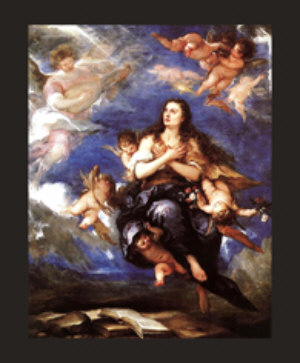
The "Assumption of Mary Magdalene" by the 13th century Spanish artist José Antolinez offers another interpretation of this experience.

Seemingly doll-sized, this is the actual Magdalene chapel built inside the grotto. Light streams onto the floor through stained glass windows in the grotto's façade.
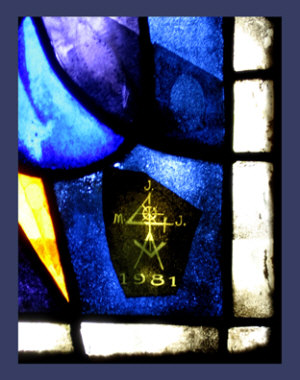
At the bottom of one of the stained-glass pieces is an insignia that seems Masonic in nature. The J's may stand for Jesus; his brother James the Just; John the Baptist; Jah, a Chaldean name for God; or Jahveh, a Hebrew name for God. The M may stand for Mary or Moses.
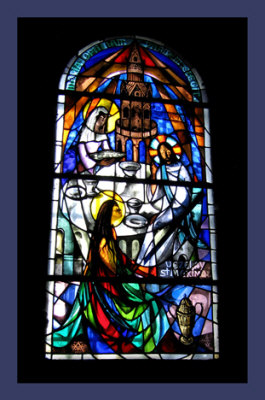
This window shows the Biblical account of the marriage at Cana. Various researchers have theorized that it was the celebration of a different kind of union.
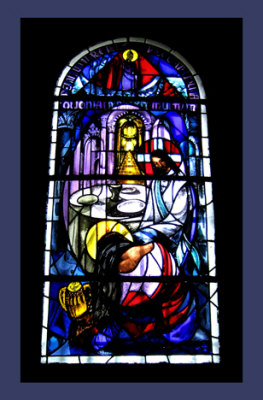
The woman in this scene is the "repentant sinner" who anointed and washed Christ's feet with her hair. The Church of Rome claimed that the sinner was Mary Magdalene.
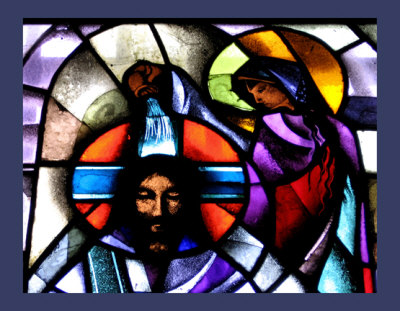
Yet in this chapel dedicated to St Mary Magdalene, she is shown anointing his head.
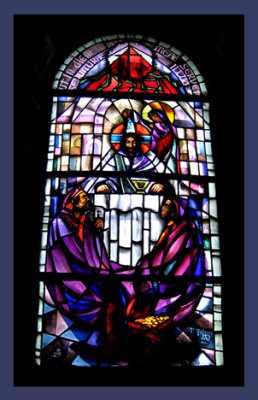
The entire piece shows two stern-looking men bearing witness to the anointing. Perhaps they are priests or "wise men." Because of the prominent appearance of gold, the scene could signify the alchemical process of transforming an ordinary man into a purified or "Christed" one.
Note the red pyramid above Christ's head with green snakes pouring from it. A red, upright pyramid is an ancient device signifying the male principle and its extension as the power of kingship. The idea is that an upward-pointing pyramid uses Earth as its basis for the strength and stability to reach for the heavens. In this context, red may signify the royal color crimson. The green snakes may represent the descent of vitality, viewed as fertility and the greening of Earth via serpentine vines.
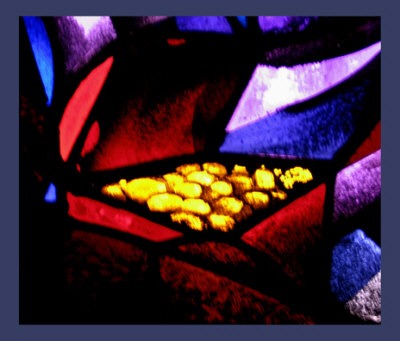
Lore suggests that the desired result of alchemy is the transformation of lead into gold. However, many alchemists refer to alchemy as an inner process whereby gross nature is transformed into rarified. The objective is to release the love contained in the human heart. Perhaps this depiction of a treasure chest symbolizes the human chest, radiant with a heart of gold.
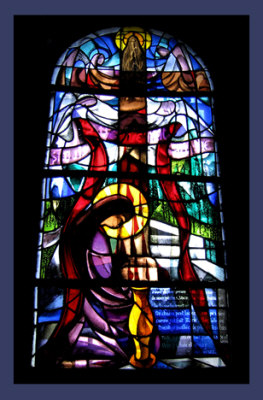
The next scene shows Mary in her traditional stance beneath the foot of the cross. What is atypical about this scene is the absence of Christ. Although difficult to read, the letters on the red scarf or shroud are V and E. They may end the word "love" or "Ave" as in Ave Maria or Ave Millennium. The figure at the zenith of the cross, with its extremely long hair, looks female rather than male. Its style is reminiscent of paintings of the Magdalene.
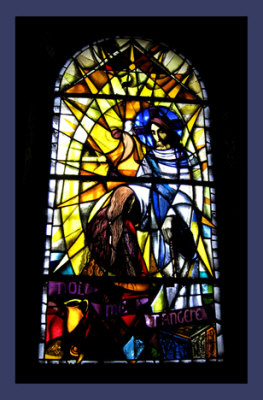
This scene shows Mary's arrival at Christ's tomb. To her "astonishment" he has returned from the dead and cautions her to refrain from touching him, noli me tangere.
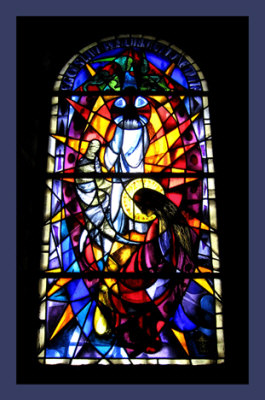
In the final scene, Christ turns his back to Mary and begins his departure. The strange mummy-like object to her left may symbolize his resurrection, the Holy Spirit, or the spirit of love issuing from her breast.
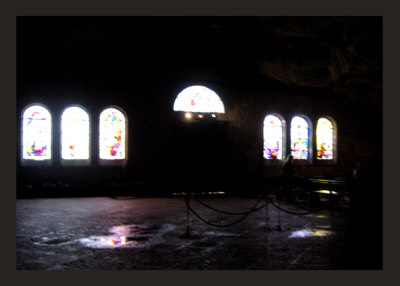
The stained glass panels are the seeker's "final illumination" as he or she leaves the chapel. As part of the shamanic experience, the sacred journeyer exits the darkness of the womb-tomb with newly acquired vision.
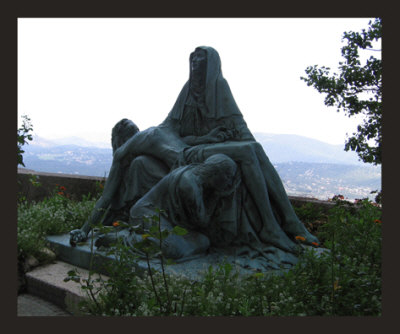
The first sight that greets the eye outside the grotto is a bronze of the Pieta. This scene is traditionally interpreted as the Virgin holding her son. Note how the curve of the mountains is reflected in the curve of Christ's chest.
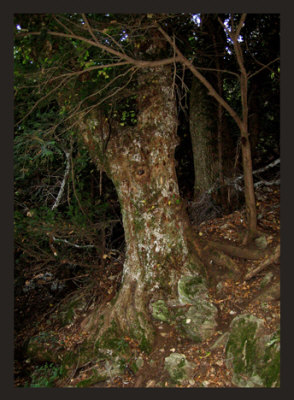
The statue rests on a terrace overlooking Provence. Although the view is breathtaking, the promise of an even more spectacular view entices the pilgrim back into the forest to take a new trail toward the mountain's summit. This stretch of forest is darker and feels more mysterious. The woods seem primeval.
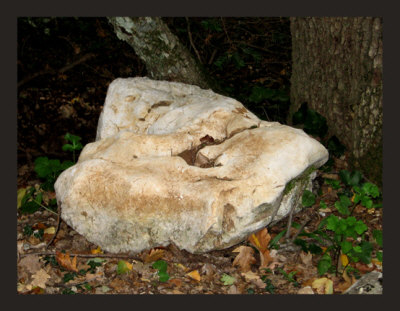
A huge, skull-like rock points the way upward.
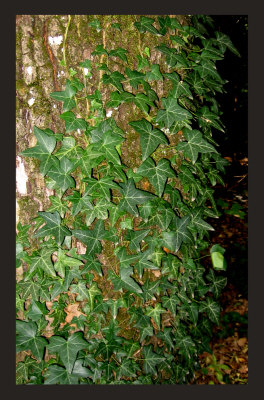
A representation of the divine feminine in the form of trefoil ivy clings to a tree trunk. Trees mythically represent the link or axis mundi between this world and the celestial sphere.
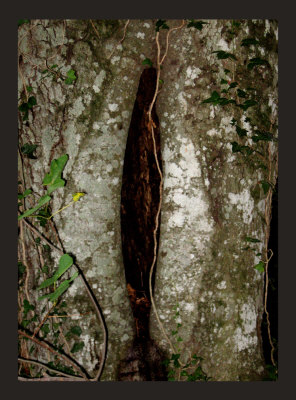
Tree bark splits into a vesica pisces— a "yoni" or portal between the worlds. A wayfarer's shelter along the summit's path is also a metaphor for the same concepts.
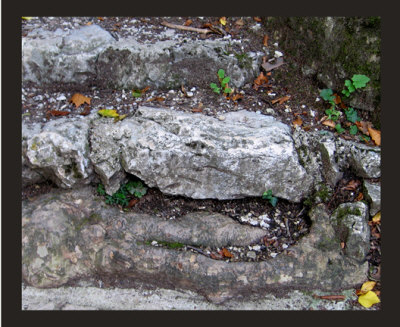
Beyond the shelter, native rock forms an ascending staircase.
The trail becomes steep and treacherous.
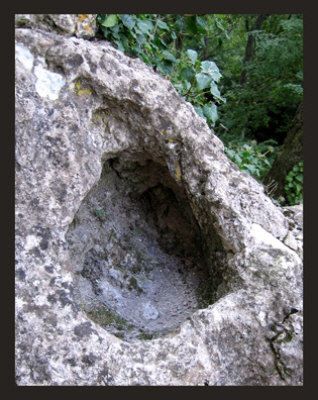
A natural baptismal-font appears in an outcrop.
Cleansing is often a prerequisite for "threshold" rites.
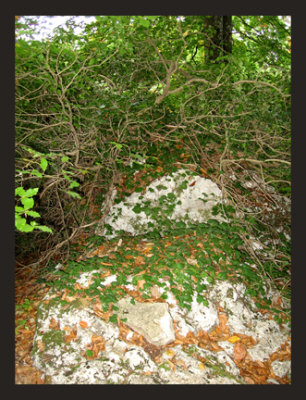
Thick forest gives way to sparse foliage near the summit.
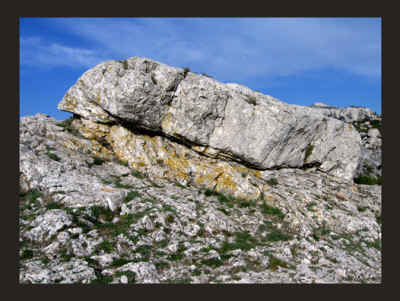
Huge boulders appear at the crest.
The view is awe-inspiring.

On a clear day, the Alps, the Ventoux, the Sainte-Victoire and the sea are visible.
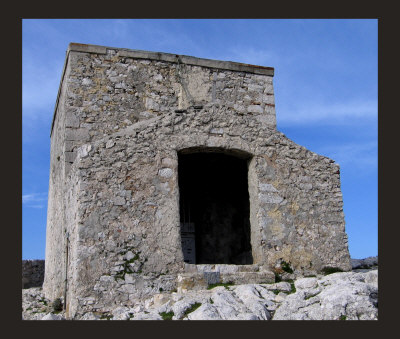
The climb ends at a shrine erected on the site where Mary Magdalene ascended from the summit of Sainte-Baume.
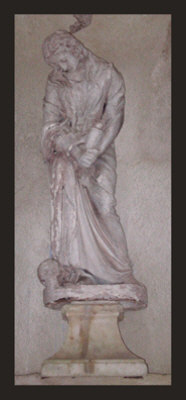
Inside the shrine is a statue of the lonely Magdalene. Her ascension offers hope to pilgrims who resonate with her isolation and wish to release their burdens and transcend the troubles of the world.
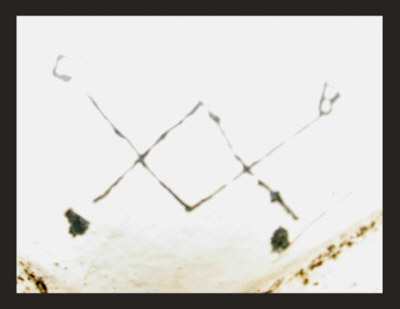
An insignia, crudely carved on the outside of the shrine, expresses the Cathar cry of "Ave Maria" or "Ave Millennium." Then as now, the call heralds a new beginning at the turn of a new millennium.
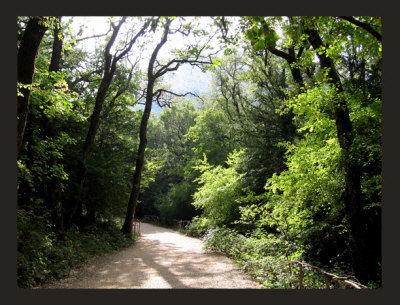
The path home through the forest is now sunlit and peaceful.
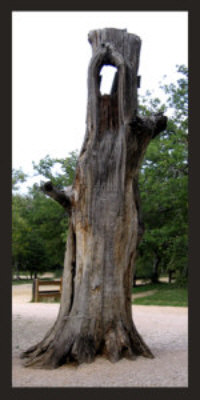
The weathered oak bids the pilgrim farewell. Her dark face, with light emanating through its "holiness," offers the hope that seeing things through a novel lens will lead to a quickening of sentience and thereby a renewal of life.
A Zero-Point Point-of-View
On October 12, 2006, eight women made a pilgrimage to the Sainte-Baume Grotto. I was one of them.
During the trek, several things captivated. Going in, our primary focus was the discovery of legends concerning Mary Magdalene. Many of us felt a special bond with the mythos.
As the journey progressed, there seemed more to it than legend. The grotto had an influence that was both activating and stilling. There was a pervasive, full-bodied hush that architects have attempted to recreate in churches and cathedrals. It seemed as though the grotto was more than a sacristy — a container for the sacred — it was the sacred. And the grotto offered it grail-like to the seeker who asked the right questions.
One of the questions that hung unanswered was the mechanics for the delivery of this life force. What stimulated me was the idea of Zero-Point-the sub-zero strata where matter is so frigid that motion seems impossible, yet movement occurs. Quantum science suggests that the zero-point may be a source of unlimited energy.
The cave seemed to store this kind of just-behind-the-veil vitality. It was as though something intense waited to be tapped.
The grotto's cistern, with its subsurface circle presented a good metaphor for the zero-point field, as did Mary's womb-like jars next to her reclining statue and the tortured torso.
The wreath encircling the red pyramid hinted at another symbol for zero-point and its serpents seemed appropriate metaphors for superstrings.
On the climb to the summit, a tree's split bark, an outcrop's natural baptismal-font, the wayfarer's shelter and the shrine at the place of ascension-all seemed to whisper: look at these things from a different point-of-view.
At journey's end, the weathered oak bidding the pilgrim farewell — her dark face with light emanating through its "holiness"— offered the final metaphor.
As sunset darkened the sky, the dome of starlight over Provençe seemed to tender a proposal that we reconsider the way we view life and our mechanisms for accessing it.
Return to Part I
Return to the Mythic Passages Menu
Subscribe to the Mythic Passages e-zine
|
